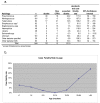Incidence of bacterial meningitis (2001-2005) in Lazio, Italy: the results of a integrated surveillance system
- PMID: 19196453
- PMCID: PMC2645407
- DOI: 10.1186/1471-2334-9-13
Incidence of bacterial meningitis (2001-2005) in Lazio, Italy: the results of a integrated surveillance system
Abstract
Background: Monitoring the incidence of bacterial meningitis is important to plan and evaluate preventive policies. The study's aim was to estimate the incidence of bacterial meningitis by aetiological agent in the period 2001-2005, in Lazio Italy (5.3 mln inhabitants).
Methods: Data collected from four sources--hospital surveillance of bacterial meningitis, laboratory information system, the mandatory infectious diseases notifications, and hospital information system--were combined into a single archive.
Results: 944 cases were reported, 89% were classified as community acquired. S. pneumoniae was the most frequent aetiological agent in Lazio, followed by N. meningitis. Incidence of H. influenzae decreased during the period. 17% of the cases had an unknown aetiology and 13% unspecified bacteria. The overall incidence was 3.7/100,000. Children under 1 year were most affected (50.3/100,000), followed by 1-4 year olds (12.5/100,000). The percentage of meningitis due to aetiological agents included in the vaccine targets, not considering age, is 31%. Streptococcus spp. was the primary cause of meningitis in the first three months of life. The capture-recapture model estimated underreporting at 17.2% of the overall incidence.
Conclusion: Vaccine policies should be planned and monitored based on these results. The integrated surveillance system allowed us to observe a drop in H. influenzae b meningitis incidence consequent to the implementation of a mass vaccination of newborns.
Figures




References
-
- WHO-recommended standards for surveillance of selected vaccine-preventable diseases. World Health Organization, Geneva; 2003.
-
- Neuman HB, Wald ER. Bacterial meningitis in childhood at the Children's Hospital of Pittsburgh: 1988–1998. Clin Pediatr (Phila) 2001;40:595–600. - PubMed
-
- Husain E, Chawla R, Dobson S, Dele Davies H. The Paediatric Investigators Collaborative Network on Infections in Canada. Epidemiology and outcome of bacterial meningitis in Canadian children: 1998–1999. Clin Invest Med. 2006;29:131–5. - PubMed
MeSH terms
LinkOut - more resources
Full Text Sources
Miscellaneous

